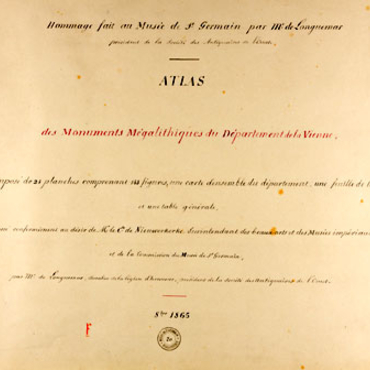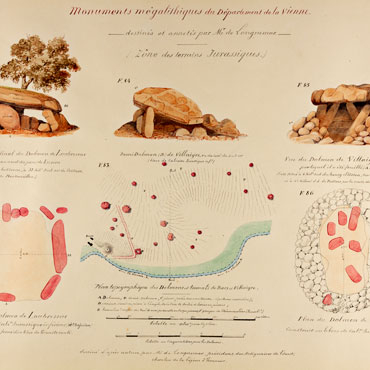
- Home
- The Commission de Topographie des Gaules
- The musée gallo-romain
- Thousands of documents
Alongside archaeological objects, models and casts there were books, archives and photographs. With its exceptional and continually expanding collection of documentary resources, the museum positioned itself as a centre for archaeological research where links between its physical collections and documentary resources were continually being made.
The library
In 1864, Verchère de Reffye and Philibert Beaune called for the building of a library, “an indispensable complement to the collections”. The Commission de Topographie des Gaules (CTG) gave a large amount of material in contribution to the bibliographical work launched by Félicien de Saulcy, donations which were supplemented by publications from the first archaeologists, often commented on by their authors.
Unparalleled archives
The manuscripts and photographs produced by CTG members and correspondents were unique. Albums by Revon and Longuemar and of the Alise-Sainte-Reine excavations; notes by General Creuly and Charles Robert; drawings by Flouest; estampages; working plans; scholars’ correspondence; and numerous glass plates and photographic prints, are just some examples of the wealth of the collections.
Giving access to documents
The library and archives on the first floor were part of the museographical endeavour and available to access from Tuesday to Saturday on request. The archaeologist Mazard acted as librarian, welcoming and directing researchers. In addition, many visual documents were displayed on the museum’s walls or in specially designed displays, contributing to the aim of educational discourse so dear to the museum’s designers.
Partners and authors
Associated media
Open Media Library

Watercolour drawing from the Album Revon

Album Fouilles d'Alise S.te Reine, 1861-1862

Extract from the Album des fouilles d'Alise-Sainte-Reine, produced by the Commission de Topographie des Gaules, 1861-1862

Album Chantre, 1866-1878

Album Chantre, plate 8, 1866-1878

Album Longuemar, 1865

Album Longuemar, title page, 1865

Album Longuemar, plate 18, 1865

Album Longuemar, plate 24, 1865

Album Cournault

